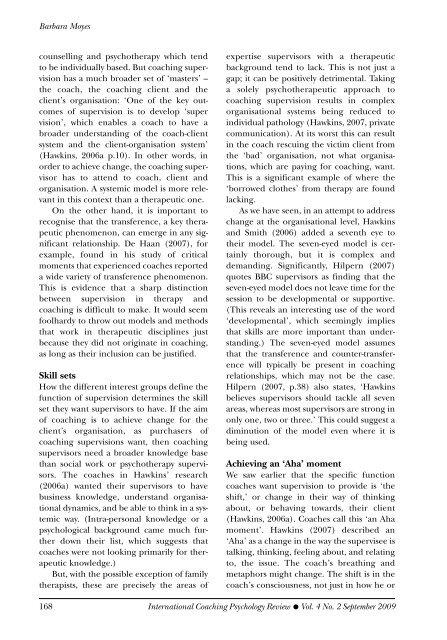International Coaching Psychology Review, 4.2, September 2009
International Coaching Psychology Review, 4.2, September 2009
International Coaching Psychology Review, 4.2, September 2009
Create successful ePaper yourself
Turn your PDF publications into a flip-book with our unique Google optimized e-Paper software.
Barbara Moyes<br />
counselling and psychotherapy which tend<br />
to be individually based. But coaching supervision<br />
has a much broader set of ‘masters’ –<br />
the coach, the coaching client and the<br />
client’s organisation: ‘One of the key outcomes<br />
of supervision is to develop ‘super<br />
vision’, which enables a coach to have a<br />
broader understanding of the coach-client<br />
system and the client-organisation system’<br />
(Hawkins, 2006a p.10). In other words, in<br />
order to achieve change, the coaching supervisor<br />
has to attend to coach, client and<br />
organisation. A systemic model is more relevant<br />
in this context than a therapeutic one.<br />
On the other hand, it is important to<br />
recognise that the transference, a key therapeutic<br />
phenomenon, can emerge in any significant<br />
relationship. De Haan (2007), for<br />
example, found in his study of critical<br />
moments that experienced coaches reported<br />
a wide variety of transference phenomenon.<br />
This is evidence that a sharp distinction<br />
between supervision in therapy and<br />
coaching is difficult to make. It would seem<br />
foolhardy to throw out models and methods<br />
that work in therapeutic disciplines just<br />
because they did not originate in coaching,<br />
as long as their inclusion can be justified.<br />
Skill sets<br />
How the different interest groups define the<br />
function of supervision determines the skill<br />
set they want supervisors to have. If the aim<br />
of coaching is to achieve change for the<br />
client’s organisation, as purchasers of<br />
coaching supervisions want, then coaching<br />
supervisors need a broader knowledge base<br />
than social work or psychotherapy supervisors.<br />
The coaches in Hawkins’ research<br />
(2006a) wanted their supervisors to have<br />
business knowledge, understand organisational<br />
dynamics, and be able to think in a systemic<br />
way. (Intra-personal knowledge or a<br />
psychological background came much further<br />
down their list, which suggests that<br />
coaches were not looking primarily for therapeutic<br />
knowledge.)<br />
But, with the possible exception of family<br />
therapists, these are precisely the areas of<br />
expertise supervisors with a therapeutic<br />
background tend to lack. This is not just a<br />
gap; it can be positively detrimental. Taking<br />
a solely psychotherapeutic approach to<br />
coaching supervision results in complex<br />
organisational systems being reduced to<br />
individual pathology (Hawkins, 2007, private<br />
communication). At its worst this can result<br />
in the coach rescuing the victim client from<br />
the ‘bad’ organisation, not what organisations,<br />
which are paying for coaching, want.<br />
This is a significant example of where the<br />
‘borrowed clothes’ from therapy are found<br />
lacking.<br />
As we have seen, in an attempt to address<br />
change at the organisational level, Hawkins<br />
and Smith (2006) added a seventh eye to<br />
their model. The seven-eyed model is certainly<br />
thorough, but it is complex and<br />
demanding. Significantly, Hilpern (2007)<br />
quotes BBC supervisors as finding that the<br />
seven-eyed model does not leave time for the<br />
session to be developmental or supportive.<br />
(This reveals an interesting use of the word<br />
‘developmental’, which seemingly implies<br />
that skills are more important than understanding.)<br />
The seven-eyed model assumes<br />
that the transference and counter-transference<br />
will typically be present in coaching<br />
relationships, which may not be the case.<br />
Hilpern (2007, p.38) also states, ‘Hawkins<br />
believes supervisors should tackle all seven<br />
areas, whereas most supervisors are strong in<br />
only one, two or three.’ This could suggest a<br />
diminution of the model even where it is<br />
being used.<br />
Achieving an ‘Aha’ moment<br />
We saw earlier that the specific function<br />
coaches want supervision to provide is ‘the<br />
shift,’ or change in their way of thinking<br />
about, or behaving towards, their client<br />
(Hawkins, 2006a). Coaches call this ‘an Aha<br />
moment’. Hawkins (2007) described an<br />
‘Aha’ as a change in the way the supervisee is<br />
talking, thinking, feeling about, and relating<br />
to, the issue. The coach’s breathing and<br />
metaphors might change. The shift is in the<br />
coach’s consciousness, not just in how he or<br />
168 <strong>International</strong> <strong>Coaching</strong> <strong>Psychology</strong> <strong>Review</strong> ● Vol. 4 No. 2 <strong>September</strong> <strong>2009</strong>

















